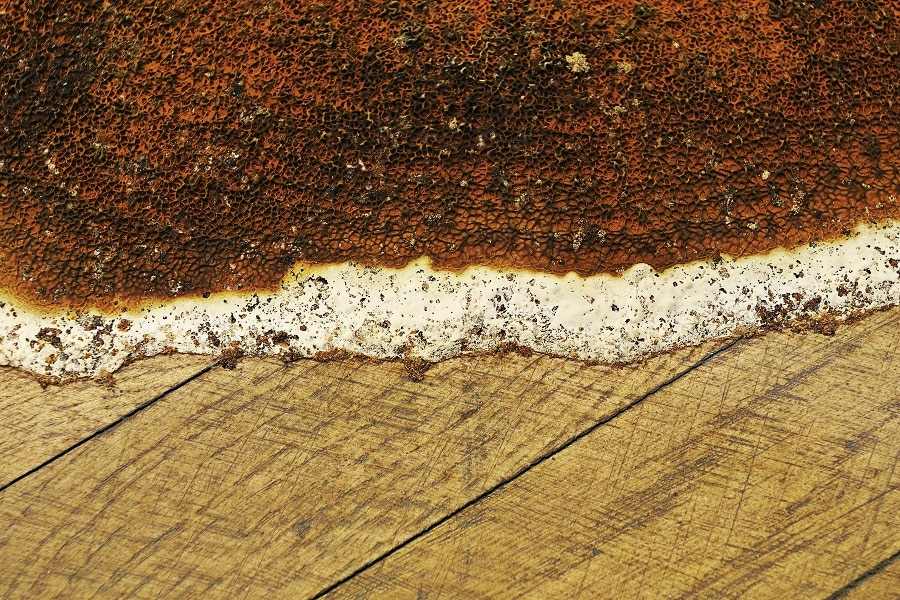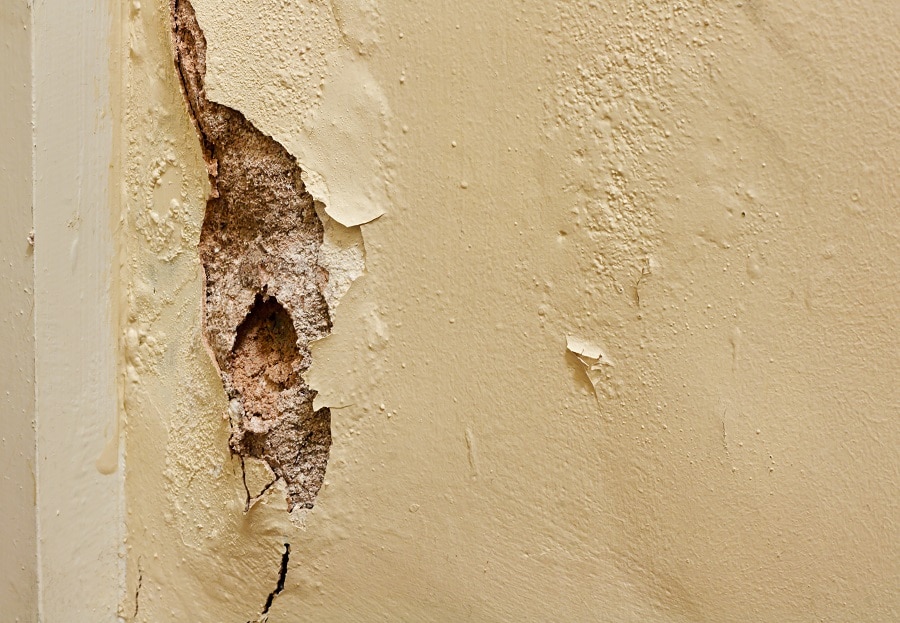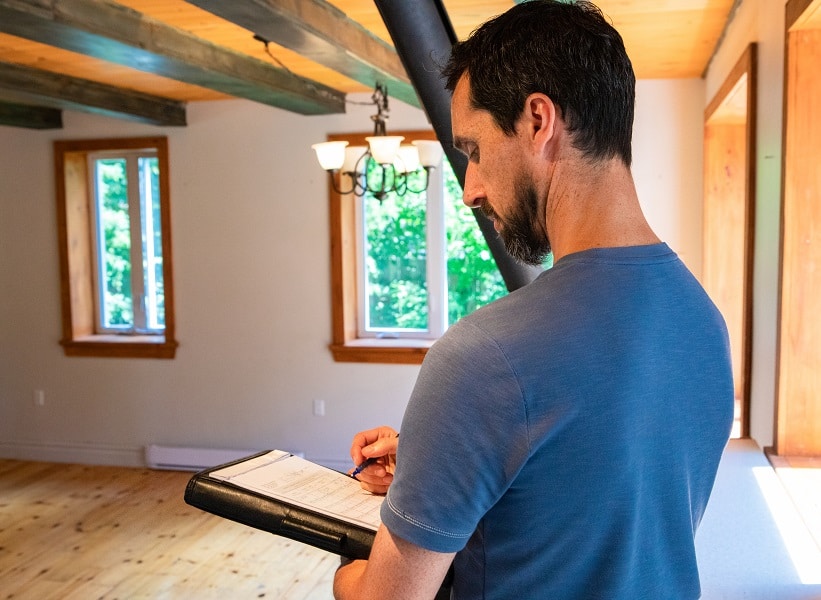What is dry rot?
Dry rot is a common term for various kinds of wood-decay fungus. Once the surface of the Wood is broken down by the Sporocarp fungi, it gives way to Mycelium that consumes the wood and dries it out effectively; the end result is a fine dust and dry rot bloom. Dry rot is caused by fungal spores which require a suitable place to land and start their colonies before spreading through the underlying wood. Many of the spores are already present in woods that are already affected by dry rot and in the soil.
This means that even treated wood can be re-infected by dry rot if it is damp enough (i.e., below 15 percent relative humidity). While Dry Rot can be harder to spot, it is potentially more damaging than wet rot. It sometimes happens where you’re not looking. This could be found behind the plaster, beneath your floorboards, or even in your loft. And while you might be tempted to ignore the signs, it’s crucial to identify them and take action immediately.
Our Guarantee
- upto 30 year guarantee
- customer focused team
- 20 years combined experience
- portfolio of satified customers
- attention to detail
- Construction line accreditation
- public liability insurance
- CHAS accreditation
What is the difference between dry rot and wet rot?
Dry rot and wet rot have distinct spores/species, which means they look different. The biggest difference between wet and dry rot is the significant moisture content that wet rot needs to spread. Another significant difference to be aware of is that wet rot can spread across larger areas faster. This is because it uses the capillaries within timber rather than mycelium that typically forms the basis of a Dry Rot infestation. Dry rot is a form of decay caused by certain types of fungus, it is the most severe type of decay and spreads too much of the structural timber. Wet rot can occur on drier timber, but it generally spreads further when it becomes wet.
Call Our Sussex Damp Experts team now for quote, consultation and advice:
Call on 01273 257 765.
What are the causes of dry rot?
A number of fungi cause dry rot. Serpula Lacrymans is the most common one in West-Sussex. If it’s not handled fast enough, it’s going to spread over your house, brick and mortar, and even plaster. It can have a major negative impact on the structural integrity of timber, and also the integrity of your home. Dry rot hits when you have too much moisture in your timber. This will attract the fungus that will use this moisture to extract nutrients. “Dry rot” is used to distinguish “wet wood” from “dry wood rot.”
Wet timber feeds on dry rot. While fungal spores need over 30% wetness to generate hyphae after this, these hyphae only need 20% wetness to survive. These cells can grow into a fungal body called a mycelium, which also spreads outward to find more wood in stone and brick. Once the rot has taken over, it weakens the wood and leaves behind a skeleton structure of the wood, removing H2O, cellulose and hemicellulose from your wood. You will require an expert survey to see if the rotting wood is affected by dry rot or by another fungus. This is important as the remedies for these damages can vary based on the actual cause.

The dangers of dry rot in West-Sussex
Dry Rot Effect on your Property
The biggest problem with dry rot is that it will rapidly attack your home’s structural integrity. Dry Rot will propagate from the basement through the ground floor and the upper foundations into the roof timbers, resultantly causing the house to crumble. In serious cases, this can trigger various parts of your house to break apart. Dry rot is actually a fungal infestation that penetrates through the mortar and spreads across the brick or stone. This is why regular checks are important.
Dry rot is a ravaging condition that affects your home and must be addressed immediately. It is important to call a Dry Rot Expert immediately before your home sustains serious damage. If you think that you might have an issue with dry rot or dampness in your home, check out Sussex Damp Experts today.
Dry Rot Effect on Your personal health
It’s not the disease that causes dry rot that is dangerous. Regrettably, if dry rot does occur, the structural damage may be extensive to your health. This is extremely unhealthy for the infants, elderly people and those with respiratory problems like asthma.
What are the Warning Signs of Dry Rot?
The earlier you discover dry rot, the less time and money you’ll need to spend treating it and initiating remedial works. If you see some of the signs and symptoms listed below, a complete examination is recommended.
-
The beginning of the dry rot cycle
Fungi spores may travel through air via wind in order to infect a new host. If they are taken to the wood, they may begin to feast on it. When the wood has enough moisture, it allows fungal spores of Armillaria mellea to germinate and create hyphae, if the timber is giving them enough nutrients to do so. As the fungus grows, strands of this tissue called hyphae form spiderweb-looking collections called mycelium. Mycelium might be light gray or solid white. This mycelium can also reach into your properties bricks, mortar and wood to try and reach more of your timber.
-
Your timber is damaged.
You are likely to start noticing rot issues if your timber begins to dry out. Your timber may collapse as a result of this. You may observe the dry rot changing the color of your timber. In fact, dry rot can result in what is called cuboid cracking. Cuboidal cracking/splitting is the result of timber breakage around 50 mm. The distinctive symptom of white rot in wood is a creamy colour to the wood due to a white fungal growth called “hyphae”. Also known as dry rot, hyphae is a common symptom of dry rot.
-
Your timber will smell.
Dry rot attacks the timber, leaving it with a distinct fungal and musty odour. This can happen even though you can’t see an epidemic of dry rot. Despite the odor, dry rot may not yet begun to grow.
-
Your timber will have fungus bodies on it.
Dry rot is the most noticeable kind of wood rot and one of the final stages of fungal attack. Fruiting bodies like Mushroom can start to attach themselves to your wood. If it becomes dry, dry rot can no longer feed on the wood so it will pop out spores instead.
-
Your timber will have spore dust.
Dry rot can affect a variety of timber that is not necessarily already rotten and damp. It could be a sign of dry rot if you see splots of rusty colored dust embedded decomposed spores. Fertile bodies supply this spore dust in the final cycle of dry rot.
Dry Rot Treatment in West-Sussex

Only when the moisture is over 20% will a dry rot invasion take place. The first prevention step to eradicating the presence of the fungus is the monitoring of moisture levels in your property. You can now control the moisture levels. To treat dry rot, we recommend you commission a professional.
Sussex Damp Experts can help you with the removal of infected timber and any remedial work. Removing affected timber needs to be actioned by a professional. A professional damp proofing expert will know the required treatment. Some treatments are injected into the timber, others coat the surface of the timber. There are also several preventative treatment options available. These chemicals require specific concentrations and can have unpleasant side effects if inhaled or injected accidentally.
Your timber may require Boron roads injection from a professional. Boron is a harmful item, therefore the protective clothing is worn by damp proofing experts. We use our specialist team at Damp Proofing to find any issues with dry rot, and assess the extent of the issue. Dry rots are a serious problem and can lead to serious issues if left untreated. Dry rots are a serious problem and can lead to serious issues if left untreated. Our Sussex Damp Experts team will work with you to implement a suitable treatment that addresses your problem effectively and efficiently. Please don’t waste time. If you believe you have a problem with dry rot, call 01273 257 765 for a free survey, and successful care today.
How can you prevent dry rot damage in West-Sussex?
The first step of treating dry rot is prevention. Wooden areas of the property, which capture ample water and which are subject to moisture/humidity, can contribute to a dry red infestation. Here are some practices that will prevent them from forming: It is your responsibility to ensure that there are no leaks in your house. Provide sufficient ventilation.
Well, ventilate and enclose the attic. Ventilate crawl spaces correctly. Waterproof the exterior of your home by sealing the basement and crawlspace floors with our durable, waterproof sealers. Check all wall and roof flashing to ensure water is being directed properly. Maintain clear sinks and downspouts. Check for plumbing/heating leaks if using a “wet” system. Owing to the humid conditions needed for dry rot fungus to be fed and germinated, the easiest way to reduce the possibility of dry rot is to decrease moisture levels. For example, if you have a pipe that is leaking, plugging the leak can help prevent dry rot.
Speak to a Dry Rot specialist in West-Sussex
We are a team of highly trained experts who will fix your dampness and help you to avoid future damage. We will perform a full damp survey of the property and give you a free estimate before we start any work. Over the years, we have helped thousands of West-Sussex homeowners with their damp problems, and we can help you too. To book a free survey and quote, call us now 01273 257 765. An expert will be able to assess your dry rot problem. This allows us to give impartial recommendations and advice on the type of treatment you will need.

We have a complete list of expert surveyors who carry out all types of surveys and assessments, from pre-purchase surveys to full structural repairs. Dry rot gets worse over time by its nature, it is important to contact us immediately if you think you have a problem. Sussex Damp Experts offers fast, professional and affordable support to help with dry rot problems affecting your home,Call us now on 01273 257 765 for help.
FAQ
Should dry rot be restored or replaced?
A certain level of dry rot can be repaired, but whether the damaged areas provide the house with structural stability, such as beams and joints, or even flooring, it is not recommended. Replace the wood in such a situation instead of repairing it. Whether you restore or rebuild the wood, it is better if you avoided the conditions that caused the rot to flourish in the first place or risked it coming back. Your roof leaks, broken gutters, or downspouts, plumbing leaks or insufficient ventilation should be inspected when considering a roof moisture accumulation You may consult a specialist to find and repair the problem.
Will you be able to treat my Dry Rot problem effectively?
With our expertly trained surveyors and specialists, a dry rot problem can be treated, rectified, and your timber can be protected for the future.
How do I discover how far Dry Rot has spread?
If you have traced the dry rot fungus quickly or not, a professional will identify the source of the problem. They will be able to trace the fungus in the different masonry and plaster from which it has spread.
How much can dry rot widen?
Dry rot spores can spread in anyplace with the right environmental settings. The reason is that they are carried in the atmosphere. If your timber has a moisture content of around 20%, and if it is in the open air, these conditions are attractive to dry rot fungus. This suggests that fungus groups can disperse to multiple materials. If dry rot is spreading across masonry and plaster, and if it reaches more timber to feed off where the timber is moist. It can widen further. Dry rot fungus needs five things to survive: the right temperature, drive rot spores, moisture, oxygen, and the food source. In any home in Brighton most of this is present.
Will dry rot stretch?
What should I do to control dry rot?
First identify the reason for your timber moist before solving it. A different treatment shall be given if the reason for your timber moisture is outside.
What are the effects of living dry rot unchecked?
Dry rot is the most insidious form of moisture that can infest property and cause permanent damage to the building if left untreated. Sometimes, once the harm is already done due to the places in which the problem is likely to be the presence of dry rot does not come to light.
Is dry rot stringent?
Dry rot can be particularly common in wooden properties, so it is essential that early signs of dry rot are identified before the damage becomes too severe.
How am I meant to know if I have dry rot?
A timber survey will assess how your timber is affected by being exposed to moisture. Later on, fruiting bodies and mycelium will be noticeable in the drive rot life-cycle.
Where can dry rot grow?
Dry rot attacks and rots timber that’s been in contact with water for a long period of time. Although it can often be mistaken for other problems in its early stages, it is important to seek advice. In every structure, both old and new, dry rot can grow. The reason being that it is caused by moisture and wetness that happen anyplace. Dry rot can be caused by leaks or weather, meaning the type of property does not affect it.




